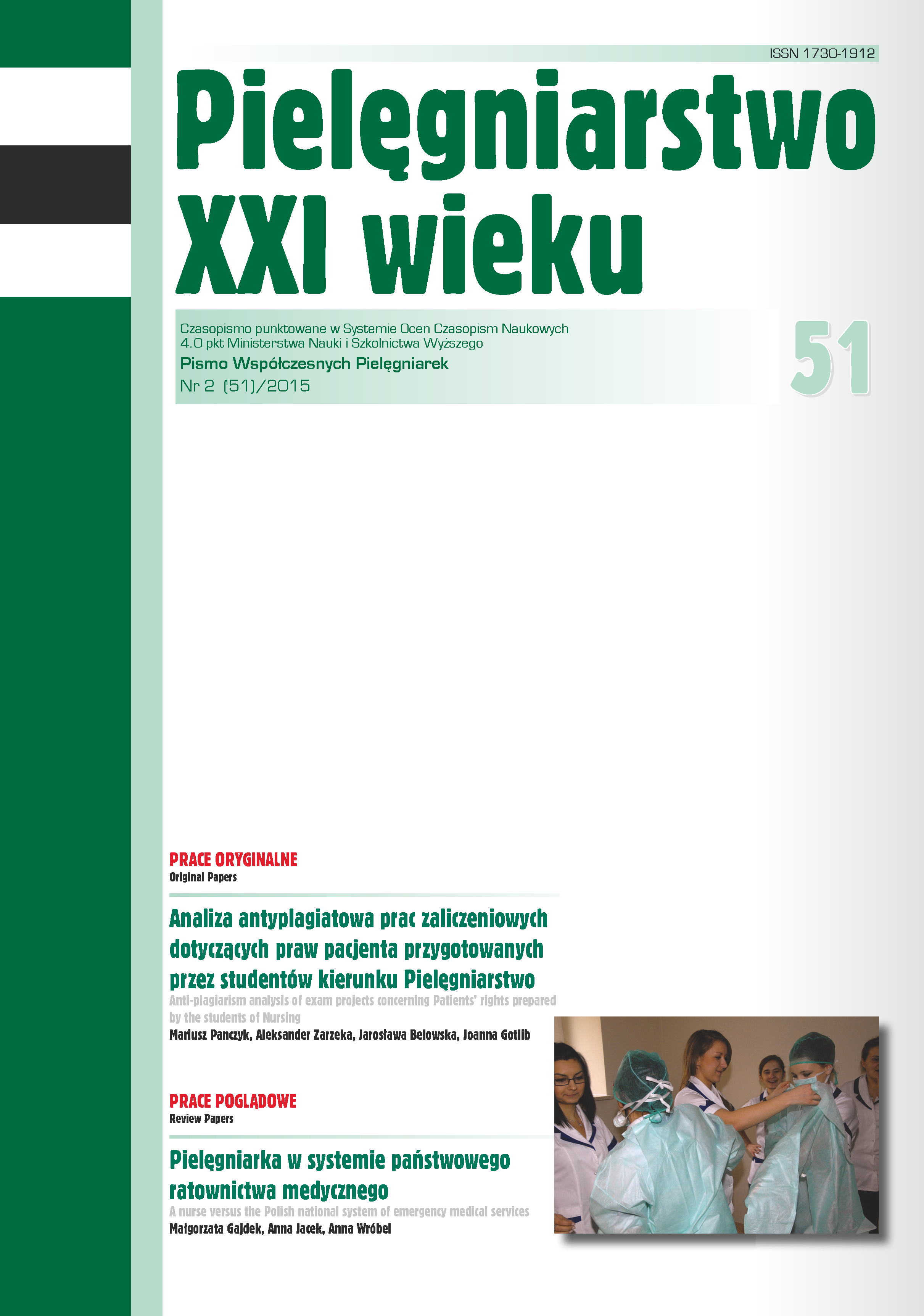Measuring the knowledge of respiratory physiotherapy among students of Nursing and Midwifery at the Medical University of Lodz
DOI:
https://doi.org/10.12923/p21w-2015-2/15Keywords:
nurse, midwife, nursing, respiratory physiotherapyAbstract
MEASURING THE KNOWLEDGE OF RESPIRATORY PHYSIOTHERAPY AMONG STUDENTS OF NURSING AND MIDWIFERY AT THE MEDICAL UNIVERSITY OF LODZ
Introduction. This paper presents an analysis of students’ knowledge about respiratory physiotherapy. All study participants were students of Nursing and Midwifery at the Medical University of Lodz. Group I included 40 students in their third year of studies, whilst group II included 40 actively working nurses and midwives, attending bridging undergraduate courses.
Aim. The aim of the study was to measure the level of respondents’ knowledge about the physiology of breathing and postural drainage, as well as to assess whether the respondents’ knowledge about different kinds of respiratory physiotherapy is sufficient for their daily nursing practice.
Material and methods. The test was conducted using a one-time, original diagnostic survey. An unbalanced, partially standardized questionnaire was used. The level of knowledge of respiratory physiotherapy and its applications among students of both groups can be rated as average. Nevertheless, full-time students had much wider theoretical knowledge of respiratory physiotherapy than students of the bridging undergraduate courses.
Conclusions. Checking the level of knowledge among the students of bridging undergraduate courses in both nursing and midwifery proves that they have sufficient knowledge for their daily nursing practice. On the other hand, full-time nursing and midwifery students do not have sufficient knowledge about respiratory physiotherapy. This means, they should complement their knowledge prior to taking a job in the field.
References
1. Rzepka A, Kędziora-Kornatowska K, Jakubczyk M, i wsp. Rola personelu pielęgniarskiego w fizjoterapii oddechowej. Pielęgniarstwo XXI wieku. 2011;4: 43- 6.
2. Rosławski A,Woźniewski M. Fizjoterapia oddechowa. Wrocław: Wyd. AWF; 2001.
3. Zborowski A. Masaż klasyczny. Kraków: Wyd. AZ; 2004.
4. McCarren B, Alison J, Lansbury G. The use of vibration in public hospitals in Australia. Physiotherapy Theory and Practice. 2003;19: 87-98.
5. Spannbauer A, Mika P, Chwała M, i wsp. Rehabilitacja u chorych po operacji klasycznej tętniaka aorty brzusznej – model stosowany w Szpitalu Zakonu Bonifratrów św. Jana Grandego w Krakowie. Piel. Chirurg. I Angiolog. 2010; 2: 40-9.
6. Nicholas S. Hill, Pulmonary Rehabilitation. Proceedings of the American Thoracic Society. 2006;3(1): 66-74.
7. https://www.harvardpilgrim.org/pls/portal/docs/page/providers/medmgmt/ medical_review_criteria/outpatient-pulmonary-rehab-criteria-6-272.pdf – data dostępu 23.06.2013 r.
8. Nowotny J. Podstawy Fizjoterapii. Kraków: Wyd. Kasper; 2004: 2.
9. Koç A. Rehabilitation nursing : applications for rehabilitation nursing. International Journal of Caring Sciences. 2012;5(2): 80-6.
10. Garrod R, Ford K, Daly C, et al. Pulmonary rehabilitation: analysis of a clinical service. Phys. Res. Int. 2004; 9(3): 111-20.
11. Esposito S, Brivio A, Tagliabue C, et al. Knowledge of oxygen administration, aerosol medicine and chest physiotherapy among pediatric healthcare workers in Italy. Journal of Aerosol Medicine and Pulmonary Drug Delivery. 2011; 24(3): 149-56.
12. Johnston CL, Maxwell LJ, Maguire GP, et al. How prepared are rural and remote health care practitioners to provide evidence-based management for people with chronic lung disease ? The Australian Journal of Rural Health. 2012; 20: 200-7.
13. Denehy L. Guest editorial – physiotherapy and thoracic surgery: Thinking beyond usual practice. Phys. Res. Int. 2008; 13(2): 69-74.
14. Pierce LL. Evidence-based practice in rehabilitation nursing. Rehabilitation Nursing. 2007; 32(5): 203-9.
15. Jacavone J, Young J. Use of pulmonary rehabilitation startegies to wean a difficult-to-wean patient: case study. Critical Care Nurse. 1998; 18(6): 29-37.
16. Spruit MA, Wouters EF. New modalities od pulmonary rehabilitation in patients with chronic obstructive pulmonary disease. Sports Med. 2007;37: 501-518.
17. Rozporządzenie Ministra Zdrowia w sprawie rodzaju i zakresu świadczeń zapobiegawczych , diagnostycznych, leczniczych i rehabilitacyjnych udzielanych przez pielęgniarkę albo położną samodzielnie bez zlecenia lekarskiego. Rozdział § 1. http://www.klrwp.h2.pl/index.php?id=280 – data dostępu 19.03.2013 r.
18. Yohannes AM, Connoly MJ. Pulmonary rehabilitation programs in UK: a national representative survey. Clinical Rehabilitation. 2004;18: 444-9.
19. O’Neill B, Elborn JS, MacMahon J, et al. Pulmonary rehabilitation and follow-on services: a Northern Ireland Survey. Chronic Respir Dis. 2008;5: 149-54.
20. Brooks D, Sottana R, Bell B, et al. Characterization of pulmonary rehabilitation programs in Canada in 2005. Can Respir J. 2007;14: 87-92.
Downloads
Published
Issue
Section
License
Copyright (c) 2024 Ewa Szczepaniak-Kucharska, Andrzej Zieliński (Autor)

This work is licensed under a Creative Commons Attribution 4.0 International License.




